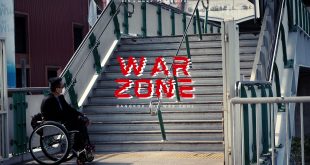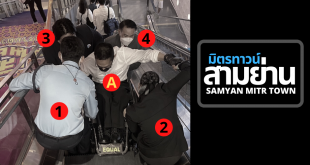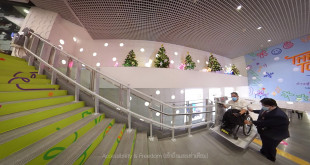<On Editing>
Anyone who is a regular user of public transports, whether BTS, MRT, or BRT, you might often recognise a mechanical device equipped beside the staircase. That device is called “stairlift,” or “platform lift.”
The purpose of this device serves as a substitution of an elevator. It’s much easier for installation and less costly to facilitate people with disabilities.
I first saw the use of stairlift in practice when I travelled in Japan. I later encountered it in Singapore and then realised that it is in use in many countries.
“Hey, they provided it for you. Just getting access is good enough right? So, what’s wrong with it?” (and with you?!!)
There were some quite aggressive feedbacks when I was offensive with the stairlift. You have to understand that it is a deliberate decision to choose a particular facilitating device among various options. Some might present more cost-effective and be easier to install. But that doesn’t mean it would be good or durable in the long-run.
In reality, along the past five years, this wonderfully stairlift device was broken so often on the BRT system. Some passengers even never find it in real use
Some of our key decision-makers might come across this device, found it wonderful, and pick it in use. Yeah, that’s a good intention, I honor. But it’s also wrong rushing to conclusion that stairlift is the best choice. Stairlift device is not universal. It means not everyone can use it, only those on not-so-large-sized wheelchair. For other passengers with special needs, such as the elderly, the pregnant, family with stroller, PWDs with personal assistant, this stairlift serves them no good. Moreover, in practice, it always needs qualified staff to operate the stairlift device. The eligible passenger cannot use it on their own. Worst, the stairlift holds a fair chance of fatal danger in case of accident.
You can visualize what I’m trying to say by watching the video below. Then you will understand. The victim could be someone you love.
In modern day, the existence of stairlift is no longer prevalent anymore in many countries like Japan. When they build a new place, they don’t add stairlift anymore. The one you see was the legacy from the old day. Its existing stairlift is still in use, though, with the highest level of safety that needs 4-5 qualified staff to facilitate one passenger to reduce the chance of an accident to the lowest. While in Thailand there are typically 1-2 staffs facilitating eligible passenger on the stairlift.
In the case of Taiwan, there used to be an accident caused by the stairlift that ultimately cost one live.
Many groups of PWDs in Taiwan are also demanding the public to ban the stairlift.
In fact, this device is complicated to use and its movement is extremely slow. You also can’t individually use it on your own, unlike elevator.
Ultimately, this thing degrades the quality of independent life. My physical body is much inferior than ordinary people. Am I now even taken my rights to get access anywhere?
Four years ago, Transportation For All (T4A) had opposed this issue to the Minister of Transport regarding the risk associated with stairlift. But the idea of stairlift remains in use even in many new places. Recently, it’s even putting into the service of a brand-new and magnificent complex of Samyan Mitrtown!!
Do you have to wait for someone losing their lives, because of stairlift, in order to stop using it?
- “An open letter to request Samyan Mitrtown to dismiss the use of stairlift:” https://www.accessibilityisfreedom.org/en/an-open-letter-requesting-samyan-mitrtown-to-dismiss-its-stairlift/
- “A fatal danger of stairlift!!!!”: https://www.accessibilityisfreedom.org/en/a-fatal-danger-of-stairlift/
- “SabaLive BTS National Stadium & and Pa-tum-wan the new skywalk survey” https://www.accessibilityisfreedom.org/en/sabalive-bts-national-stadium-and-pa-tum-wan-the-new-skywalk-survey/
- “Test: Platform Lift in Japan” https://www.accessibilityisfreedom.org/en/test-platform-lift-japan/
- “เอกสารคัดค้านการใช้งาน Platform Lift (ฉบับยื่น รมต คมนาคม)” https://www.accessibilityisfreedom.org/เอกสารคัดค้านการใช้งาน-platform-lift/
- “ทดสอบ Stair Lift รถไฟฟ้าสายสีม่วง สถานีตลาดพลู” https://www.accessibilityisfreedom.org/sabalive-รถไฟฟ้าสายสีม่วง-ตอน1-ทดสอบ-platform-lift/
- “ทดสอบ Stair Lift รถไฟฟ้าสายสีม่วง สถานีบางพลู” https://www.accessibilityisfreedom.org/ทดสอบ-platform-lift-ระบบรถไฟฟ้าสายสีม่วง/
 Accessibility Is Freedom เข้าถึงและเท่าเทียม | Accessible and Equal
Accessibility Is Freedom เข้าถึงและเท่าเทียม | Accessible and Equal


